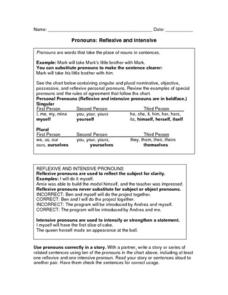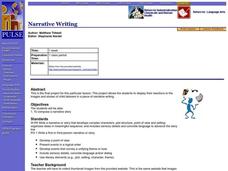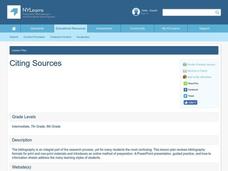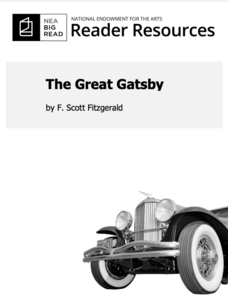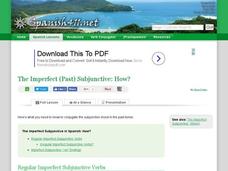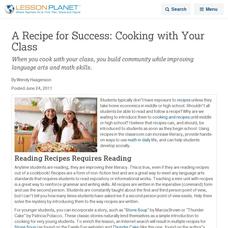Curated OER
Pronouns: Reflexive and Intensive
What is the difference between reflexive and intensive pronouns? To find out, review the definitions and examples for various types of pronouns. Then complete several activities that help the class learn to recognize and use pronouns....
Curated OER
Citing Sources
Students explore the purpose and requirements for a bibliography. They examine where to find bibliographic information in a variety of print and non-print sources on an assigned topic. Students prepare a bibliography online using a...
Curated OER
Narrative Nuts and Bolts
After viewing slides and reading about child labor, young authors compose an original narrative story. They practice note-taking skills and work to effectively engage a reader by incorporating plot, logical order, complex characters,...
Curated OER
Narrative Writing
Imagine a day in the life of a child who has to work 12-14 hours a day, seven days a week. After viewing images and reading stories of child laborers, class members select an image and write a richly detailed narrative about a typical...
Curated OER
Author's Day
Have your learners choose an author to study. One resource link gives a list of approved authors. Scholars read at least three works produced by that author and produce three separate book reports as well as a two-page author report....
Curated OER
Citing Sources
Practice citation skills with this activity, which takes learners to the Library/Media center. There, they will view a Powerpoint presentation and practice collecting data in both print and non-print sources. All necessary materials are...
Curated OER
The Subjunctive
How are subjunctives incorporated into the writing process? Young grammarians investigate the proper usage of the subjunctive mood, and combine parts of sentences from one column with those from another column to make eight logical...
Curated OER
Elements of Fiction
The metaphor of a pot of soup and a series of colorful templates remind young writers of the elements that make for a rich story. Pepper the plot with carrot/character, potato/point of view, corn/conflict, tomato/theme, and season with...
Curated OER
Identify Narrative Perspective 3
In this point of view worksheet, students read passages and then write the narrator's point of view and how they know it is such. Students do this for 6 passages.
Book Units Teacher
Story Elements
This 97-slide PowerPoint uses Charles Dickens's A Christmas Carol, Wilson Rawls, Where the Red Fern Grows, and Jeanne DuPrau's The City of Ember, to illustrate the elements of a story. Setting, plot, characterization...
Curated OER
Things in a Line
Little learners recognize symbols, objects and how to depict numbers. In this matching lesson, they can match the number names with a set of items, model ordinal numbers, and complete a cute, cartoon-character worksheet.
Premier Literacy
Point of View
Incorporate technology into a literature lesson with an innovative language arts lesson. Middle schoolers read an electronic version of original stories or fairy tales, and after determining the point of view, rewrite the tale from...
Curated OER
Asking For Directions
In this asking questions learning exercise, students solve a word problem involving asking the minimum number of questions for directions. Students complete 1 complicated higher order thinking problem.
Curated OER
The Right Point of View
Helping students identify and apply point of view in reading and writing.
National Endowment for the Arts
Reader Resources: The Great Gatsby by F. Scott Fitzgerald
A handy guide offers high schoolers support as they read the American novel, The Great Gatsby. Complete with a biography of F. Scott Fitzgerald, a timeline of the Roaring Twenties, discussion questions about the novel, and more, this...
Pearson
The Simple Present: Affirmative and Negative Statements
The present tense is a helpful skill to review in any language arts classroom. Focusing on statements made in the affirmative and in the negative, a slideshow presentation guides pupils through grammar rules and examples for the simple...
Syracuse City School District
Literary Elements
Address the literary elements in a piece of writing using these materials. The packet includes plenty of resources, and focuses mainly on theme, character, and point of view, with some materials for setting, symbolism, and author's...
Illinois Elementary School Association
Improv Exercises
Here's an eight-page packet that describes 70 different improv activities to use as warm ups for drama classes.
Curated OER
The Imperfect (Past) Subjunctive: How?
Teach your class how to form the imperfect subjunctive. Included here is information on and examples of regular imperfect subjunctive verbs, irregular imperfect subjunctive verbs, and imperfect subjunctive -se endings displayed in long...
Curated OER
A Recipe for Success: Cooking with Your Class
When you cook with your class, you build community while improving language arts and math skills.
For the Teachers
Sequence Plot Chart
Your kids can identify the plot sequence of a short story, but what about an informational article? Have them examine the chronological order of events in informational texts with a lesson on the sequence of events.
Curated OER
Nibble, Nibble, Little Mouse
Students complete activities to analyze points of view in different texts. In this point of view instructional activity, students read Hansel and Gretel and The Magic Circle and discuss the points of view. Students choose a character...
Curated OER
During Reading Strategy for Charles Dickens’ Great Expectations
Readers create a literary scrapbook for one of the characters in Charles Dickens' Great Expectations and fill it with mementoes, journal entries, letters, etc. A great way to get kids to think about characterization.
Curated OER
Subject-Verb Agreement
Perfect for a middle school classroom, this two-page reference guide introduces subject-verb agreement and gives 10 specific explanations and examples. Then, independently, attempt the 15 sentences that follow. Learners must select the...
